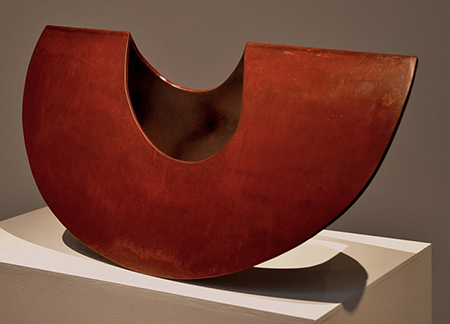
Continuing through February 25, 2023
Steve Murphy’s last one-man exhibition in Houston was in 2016, so this mini-retrospective presents an opportunity to see not only his newest work but a fresh selection of past pieces as well. Since his signature barbed-wire-wrapped wood sculpture of the mid-1990s, Murphy’s work has evolved into geometric sculptures in an array of shapes, sizes, and media. The forty-eight pieces here date back as far as 2004, half of them realized in the last three pandemic-riddled years.
Working with a vocabulary of organic shapes, Murphy varies his materials, surface textures and colors. There are floor and wall pieces, large and small works, acrylic paintings on canvas and pastels on torn paper. The surfaces of his sculptures are always flawlessly finished. He uses gold leaf, polychrome, lead and graphite to enhance wood and fiberglass, while other pieces are fabricated with steel, copper, or bronze. Murphy has always worked in wood, even outside his creative practice, from making children’s toys to redoing a century house in North Carolina. He became interested in mid-century modern furniture after being drawn to its elegant clean lines. This led to the formalist sculptures he is primarily known for, some of which have curved bottoms incorporating an element of motion and a sense of tension.
Although Murphy studied ceramics in college and painting in graduate school, he took a full-time job in the engineering field building models for industrial engineers. “I discovered that engineering is all about working with different materials and solving problems that may arise,” he said. He realized early on that he had a talent for visualizing three-dimensional forms, and his background in ceramics became the basis for many of the shapes he favors.
Like his sculptures, Murphy’s pastels and paintings are abstract and geometric. He builds up layer upon layer of pastel or acrylic, resulting in playful encounters, especially with color. The designs reflect his interest in topographical maps, as well as the graphs and charts he encountered in a day job. In “It’s All Too Much,” an asymmetrical canvas has two sets of oval rings layered over it, creating a figure-ground relationship in which the top set appears to hover over the bottom set. Some designs are based on performance graphs of a pumpjack, a device used in the petroleum industry to extract crude oil from the ground.
Murphy’s work ranges from iconic monumental sculptures to witty, playful paintings, all with sensual surfaces. The artist is a perfectionist, and the results of his exactitude are both serene and elegant. According to Murphy, “I want the viewer to slow down, have a quiet, meditative-like experience when contemplating these works and hopefully, walk away with a fresh way of seeing and experiencing the world around them.”
